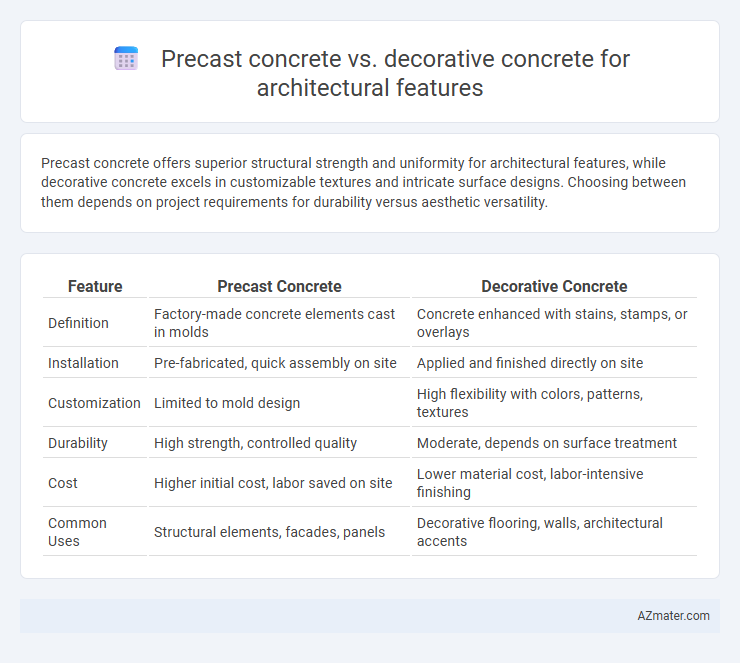Precast concrete offers superior structural strength and uniformity for architectural features, while decorative concrete excels in customizable textures and intricate surface designs. Choosing between them depends on project requirements for durability versus aesthetic versatility.
Table of Comparison
| Feature | Precast Concrete | Decorative Concrete |
|---|---|---|
| Definition | Factory-made concrete elements cast in molds | Concrete enhanced with stains, stamps, or overlays |
| Installation | Pre-fabricated, quick assembly on site | Applied and finished directly on site |
| Customization | Limited to mold design | High flexibility with colors, patterns, textures |
| Durability | High strength, controlled quality | Moderate, depends on surface treatment |
| Cost | Higher initial cost, labor saved on site | Lower material cost, labor-intensive finishing |
| Common Uses | Structural elements, facades, panels | Decorative flooring, walls, architectural accents |
Understanding Precast Concrete
Precast concrete is a versatile construction material manufactured by casting concrete in reusable molds at a controlled factory environment, ensuring consistent quality and strength. It offers precise architectural features with enhanced durability, faster installation times, and reduced on-site labor compared to decorative concrete, which is poured and finished directly on-site to achieve aesthetic textures and colors. Understanding the benefits of precast concrete includes its resistance to weathering, minimal maintenance needs, and ability to incorporate complex shapes and detailed designs essential for large-scale architectural elements.
Overview of Decorative Concrete
Decorative concrete offers versatile design options such as stamped patterns, color staining, and exposed aggregates, making it ideal for enhancing architectural features with unique textures and visual appeal. This method allows on-site customization, adapting to specific shapes and complex forms, unlike the standardized nature of precast concrete. Its ability to integrate artistic finishes while maintaining structural integrity makes decorative concrete a preferred choice for creative and functional architectural elements.
Key Differences Between Precast and Decorative Concrete
Precast concrete offers precise, factory-controlled composition and curing, resulting in uniform strength and dimensional accuracy ideal for repetitive architectural features, while decorative concrete emphasizes aesthetic customization through surface treatments like stamping, staining, or engraving directly on site. The key difference lies in functionality versus artistry; precast elements serve structural and modular purposes with rapid installation, whereas decorative concrete enhances visual appeal and texture, allowing for unique, site-specific designs. Maintenance and durability vary, with precast concrete typically providing longer lifespan and resistance to environmental factors compared to decorative concrete, which may require regular sealing to preserve its appearance.
Applications in Modern Architectural Features
Precast concrete is widely used in modern architectural features for its high durability, precision, and ability to create complex shapes off-site, making it ideal for structural elements like facades, columns, and panels. Decorative concrete excels in providing customizable aesthetics through stamping, staining, and polishing, commonly applied in interior flooring, feature walls, and outdoor pavements to enhance visual appeal. Both materials offer distinct advantages in terms of application, with precast concrete emphasizing structural integrity and decorative concrete focusing on surface artistry in contemporary architectural design.
Design Flexibility and Customization
Precast concrete offers consistent quality and rapid installation with moderate design flexibility, making it ideal for large-scale architectural features requiring uniformity and structural precision. Decorative concrete provides superior customization options, including intricate patterns, textures, and color variations, enhancing aesthetic appeal and allowing architects to create highly tailored, unique designs. Balancing the need for design flexibility versus production efficiency guides the optimal choice between precast and decorative concrete in architectural projects.
Installation Processes Compared
Precast concrete offers faster installation as components are manufactured off-site under controlled conditions, ensuring precise dimensions and reducing on-site labor time. Decorative concrete requires more extensive on-site preparation, including formwork, coloring, stamping, and curing, which can prolong installation but allows for custom, integrated design features. Choosing between precast and decorative concrete depends on project timelines, design complexity, and the desired aesthetic impact of the architectural feature.
Durability and Longevity Factors
Precast concrete offers superior durability and longevity for architectural features due to its controlled manufacturing environment, resulting in enhanced strength and resistance to weathering and cracking. Decorative concrete, while versatile and customizable with finishes like stamping or staining, may require more frequent maintenance and sealing to preserve its aesthetic and structural integrity. Choosing precast concrete ensures consistent quality and long-lasting performance, making it ideal for high-impact or load-bearing architectural elements.
Cost Considerations for Projects
Precast concrete offers cost advantages through controlled factory production, reducing onsite labor and minimizing waste, making it a budget-friendly choice for architectural features in large-scale projects. Decorative concrete, while offering customizable aesthetics such as stamping, staining, and polishing, may involve higher labor costs and longer installation times due to specialized finishing techniques. Project scale, complexity, and design requirements drive cost considerations between precast's efficiency and decorative concrete's visual flexibility.
Sustainability and Environmental Impact
Precast concrete offers superior sustainability through controlled factory production, leading to reduced waste and lower energy consumption compared to on-site casting. Decorative concrete, while versatile in aesthetics, often requires additional coatings and treatments that can introduce volatile organic compounds (VOCs) impacting environmental quality. Choosing precast concrete for architectural features minimizes carbon footprint due to efficient material use and durability, supporting long-term environmental benefits.
Choosing the Right Concrete for Your Architectural Vision
Precast concrete offers precision and durability, making it ideal for complex architectural features requiring uniformity and rapid installation. Decorative concrete provides versatile aesthetics with customizable patterns, colors, and textures, perfect for unique, artistic designs enhancing visual appeal. Selecting the right concrete depends on project priorities such as structural performance, design flexibility, budget, and installation timeframe to achieve the desired architectural vision.

Infographic: Precast concrete vs Decorative concrete for Architectural feature
 azmater.com
azmater.com